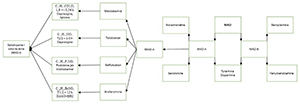Monoamine oxidase inhibitors (MAOI): pharmacology, metabolism and application in the treatment of depression
DOI:
https://doi.org/10.18388/pb.2021_382Abstract
The aim of this article is to synthesize informations about monoamine oxidase inhibitors drugs (MAOI) used in the treatment of depression. General informations on monoamine oxidase (MAO) and its kinetic properties are presented. MAO is an enzyme that degrades catecholamines and their 3-methoxy derivatives and other monoamines, for example serotonin or tryptamine. The criteria and symptoms of depressive disorders are discussed. They have to be distinguished from the state of sadness and similar states. The basic symptoms include: voice, facial expressions, anhedonia and psychomotor slowness. They may differ in individual diagnostic units. The following basic mechanism of the pharmacological action of MAOI has been indicated: when a drug inhibits MAO, the degradation of monoamines decreases and the concentration of the neurotransmitter in the synaptic cleft increases. Informations on selected selective and reversible MAOI-A are presented in the following sections. These are currently the safest and most effective MAOI drugs that can be used in the treatment of depressive diseases. The following drugs are discussed: moclobemide, befloxatone, toloxatone and brofaromine. Final conclusions are given and the presented data summarized.

Published
Issue
Section
License
Copyright (c) 2021 Advances in Biochemistry

This work is licensed under a Creative Commons Attribution 4.0 International License.
All journal contents are distributed under the Creative Commons Attribution-ShareAlike 4.0 International (CC BY-SA 4.0) license. Everybody may use the content following terms: Attribution — You must give appropriate credit, provide a link to the license, and indicate if changes were made, ShareAlike — If you remix, transform, or build upon the material, you must distribute your contributions under the same license as the original. There are no additional restrictions — You may not apply legal terms or technological measures that legally restrict others from doing anything the license permits.
Copyright for all published papers © stays with the authors.
Copyright for the journal: © Polish Biochemical Society.



